Rod Building Tips – Part 1
Basic Thread Weaving
I decided to do something special for this site in this writeup. Lets look at the process involved in basic pattern weaving. I am in no way an expert at weaves. I have done several over the years ranging from simple names and initials to single color logos. These types of weaves are the most basic and involve one base wrap thread and single color pattern threads. So what are the base wrap and pattern threads?
The base wrap thread is the base thread that wraps around and up the blank. This is the base in which the pattern threads are weaved in and out of. This thread will be a continuous wrap up the blank. The Pattern threads are the group of threads laying parallel to the blank. The pattern threads can consist of a single color or multi colors (Layers) for more complex color changing weaves.
The weave patterns are also broke up into thread counts for both vertical (base wrap) and Horizontal (Pattern Threads). For example a weave with a thread count of 120 X 60 would have 120 Base wraps around the rod and 60 pattern threads. The base wraps always wrap around the rod and the pattern threads are either moved to the left or right of the pattern. The pattern thread movement to the left or right is dictated by the weave pattern. A pattern thread that is to the right will be hidden under the base wrap and a pattern thread to the left will show up on top of the base wrap. The movement of these threads left and right with the continuous base wrap up the blank creates the weave.
No how do you turn a logo, Name, or image to a weave? There is software around that will convert images into Left lists and label everything nicely. You can also buy patterns from several vendors that do all the dirty work for you. But what if you have a custom logo say the Maryland Kayak Fishing logo? How do we convert this logo into a nice weave on a fishing rod? There is no easy way minus the options I mentioned above. You will have to somehow transpose the image onto a graph and then mark the cells where a pattern thread is present. Every cell containing a pattern thread will become a Left thread. Any space void of a pattern thread will become a Right Thread. So what does the final left list look like?
Here is the full pattern left list I created for the sites logo. Thanks Grilled Sardine for permission to use this artwork.

Lets zoom in and see whats going on in this pattern.
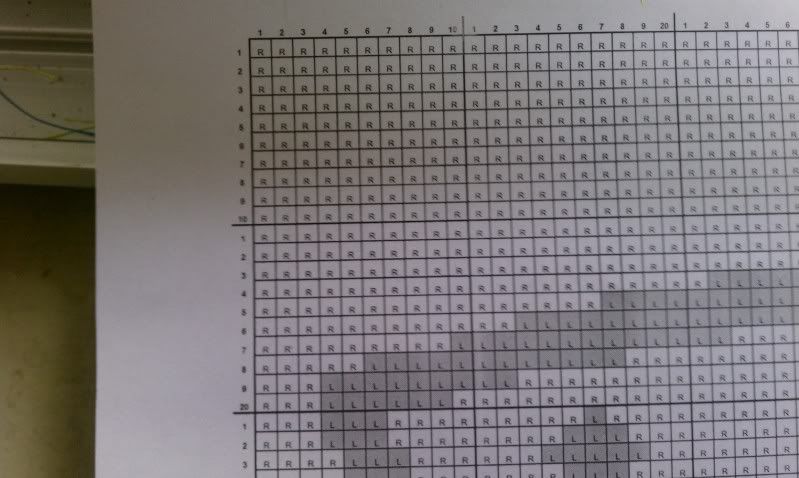
As you see the pattern is broken up into Segments. 1 thru 10 on the horizontal (Base Wrap) and 1 thru 10 on the vertical (Pattern Threads). This numbering continues in the next segment for the 20's, 30's up to the pattern end. This numbering is the thread count of the pattern mentioned earlier. Every Vertical column relates to a full base wrap around the rod. Every horizontal row relates to a single pattern thread. In this example our pattern will be 133 x 60 (133 base wraps and it will contain 60 pattern threads).
Looking closer we can see the pattern threads left and right rules spanning across the weave. These markers will tell us when to move a pattern thread to the left or right.
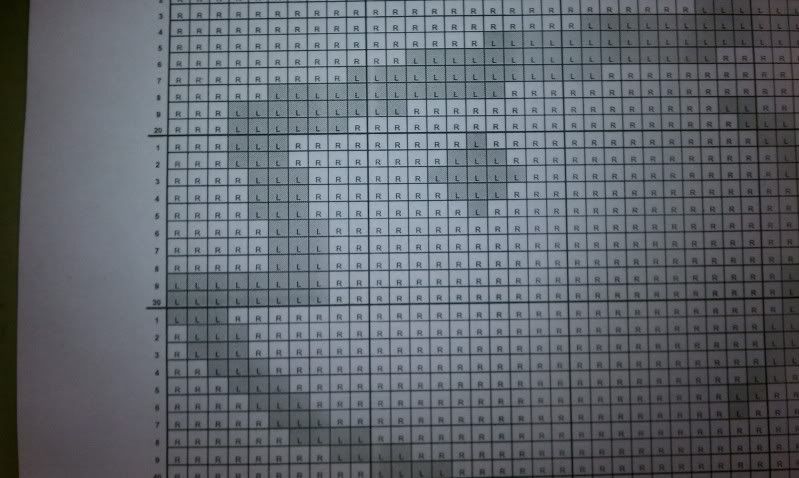
Now how do we get this on the rod? We need a way to hold 60 horizontal threads parallel to the blank and at the same time keep track of all these threads individually. The answer to this is a weaving loom (Jig). You can buy pre-made looms from vendors ranging form 40 pattern threads to looms that allow you to weave around the whole circumference of the blank.
For the basic weaves I have made a simple loom using scrap wood and some foam strips glued in place. Slits were cut into the foam strips to hold the threads and I marked the thread counts relating to location. As you see not only did I mis count when I originally labeled everything a also reversed on side. This explains the messy and mislabeled loom.
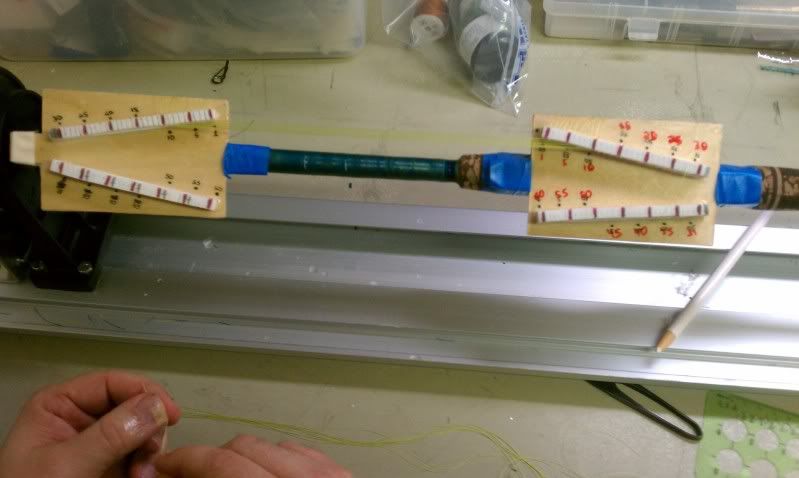
The loom will need to be secured to the blank with tape on either side of the weaves intended location. The pattern thread will be cut to size and inserted into both sides of the loom running parallel to the blank.
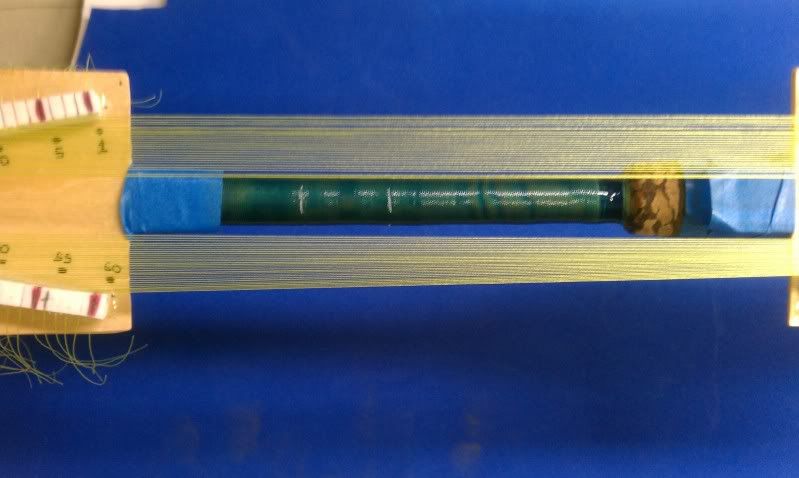
Leave 3 or 4 inches of extra thread hanging off the right side of the loom. You will need this extra thread when snugging down the base wrap.
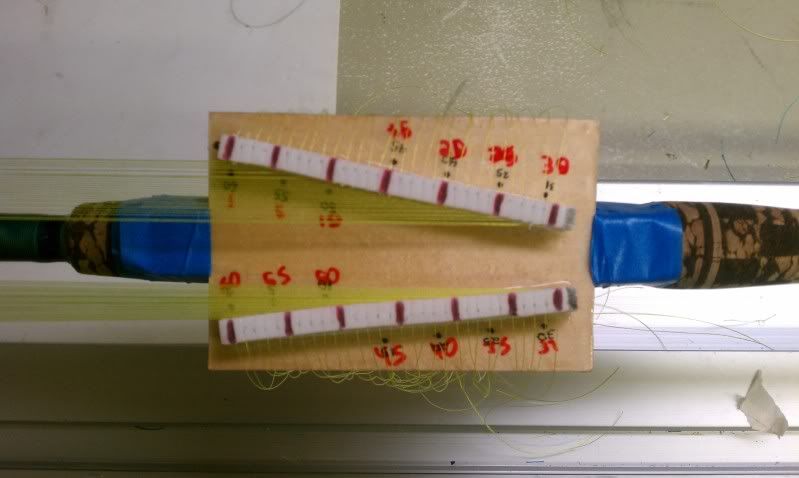
Basic Thread Weaving
I decided to do something special for this site in this writeup. Lets look at the process involved in basic pattern weaving. I am in no way an expert at weaves. I have done several over the years ranging from simple names and initials to single color logos. These types of weaves are the most basic and involve one base wrap thread and single color pattern threads. So what are the base wrap and pattern threads?
The base wrap thread is the base thread that wraps around and up the blank. This is the base in which the pattern threads are weaved in and out of. This thread will be a continuous wrap up the blank. The Pattern threads are the group of threads laying parallel to the blank. The pattern threads can consist of a single color or multi colors (Layers) for more complex color changing weaves.
The weave patterns are also broke up into thread counts for both vertical (base wrap) and Horizontal (Pattern Threads). For example a weave with a thread count of 120 X 60 would have 120 Base wraps around the rod and 60 pattern threads. The base wraps always wrap around the rod and the pattern threads are either moved to the left or right of the pattern. The pattern thread movement to the left or right is dictated by the weave pattern. A pattern thread that is to the right will be hidden under the base wrap and a pattern thread to the left will show up on top of the base wrap. The movement of these threads left and right with the continuous base wrap up the blank creates the weave.
No how do you turn a logo, Name, or image to a weave? There is software around that will convert images into Left lists and label everything nicely. You can also buy patterns from several vendors that do all the dirty work for you. But what if you have a custom logo say the Maryland Kayak Fishing logo? How do we convert this logo into a nice weave on a fishing rod? There is no easy way minus the options I mentioned above. You will have to somehow transpose the image onto a graph and then mark the cells where a pattern thread is present. Every cell containing a pattern thread will become a Left thread. Any space void of a pattern thread will become a Right Thread. So what does the final left list look like?
Here is the full pattern left list I created for the sites logo. Thanks Grilled Sardine for permission to use this artwork.

Lets zoom in and see whats going on in this pattern.

As you see the pattern is broken up into Segments. 1 thru 10 on the horizontal (Base Wrap) and 1 thru 10 on the vertical (Pattern Threads). This numbering continues in the next segment for the 20's, 30's up to the pattern end. This numbering is the thread count of the pattern mentioned earlier. Every Vertical column relates to a full base wrap around the rod. Every horizontal row relates to a single pattern thread. In this example our pattern will be 133 x 60 (133 base wraps and it will contain 60 pattern threads).
Looking closer we can see the pattern threads left and right rules spanning across the weave. These markers will tell us when to move a pattern thread to the left or right.

Now how do we get this on the rod? We need a way to hold 60 horizontal threads parallel to the blank and at the same time keep track of all these threads individually. The answer to this is a weaving loom (Jig). You can buy pre-made looms from vendors ranging form 40 pattern threads to looms that allow you to weave around the whole circumference of the blank.
For the basic weaves I have made a simple loom using scrap wood and some foam strips glued in place. Slits were cut into the foam strips to hold the threads and I marked the thread counts relating to location. As you see not only did I mis count when I originally labeled everything a also reversed on side. This explains the messy and mislabeled loom.

The loom will need to be secured to the blank with tape on either side of the weaves intended location. The pattern thread will be cut to size and inserted into both sides of the loom running parallel to the blank.

Leave 3 or 4 inches of extra thread hanging off the right side of the loom. You will need this extra thread when snugging down the base wrap.


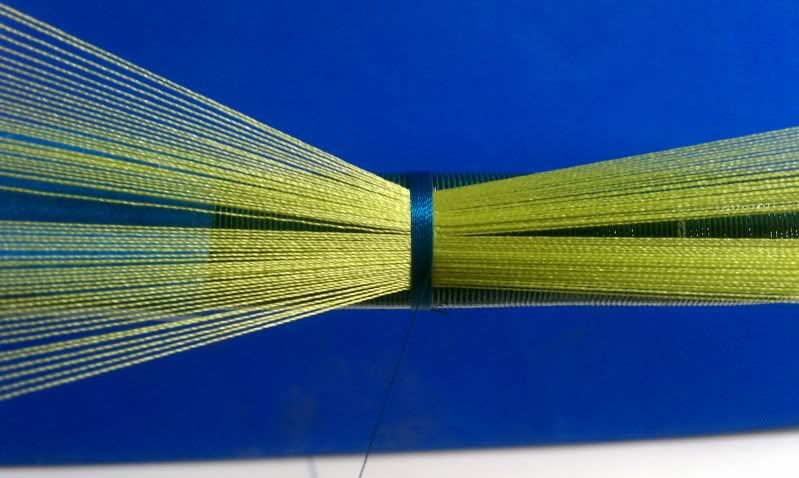
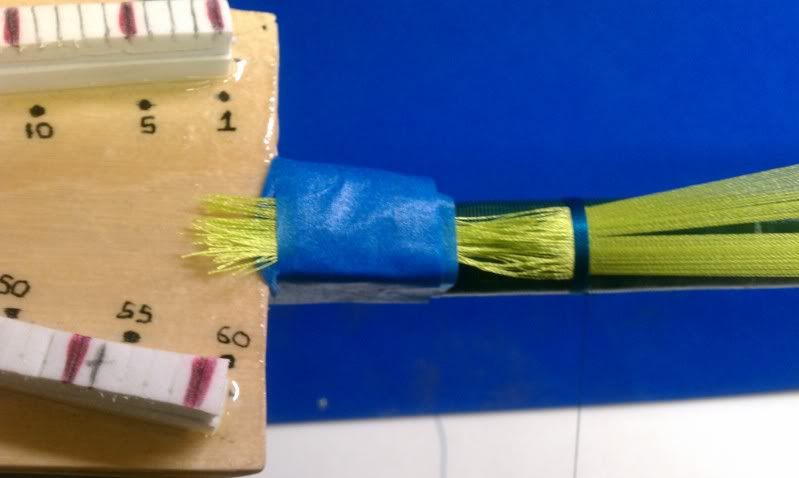

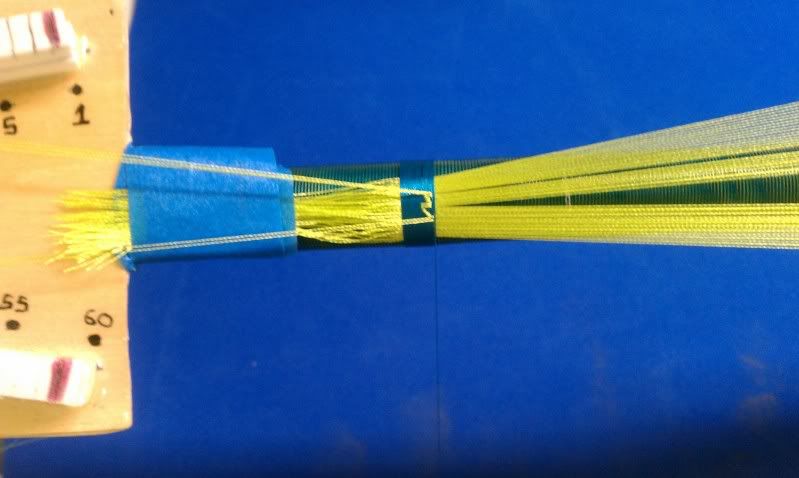

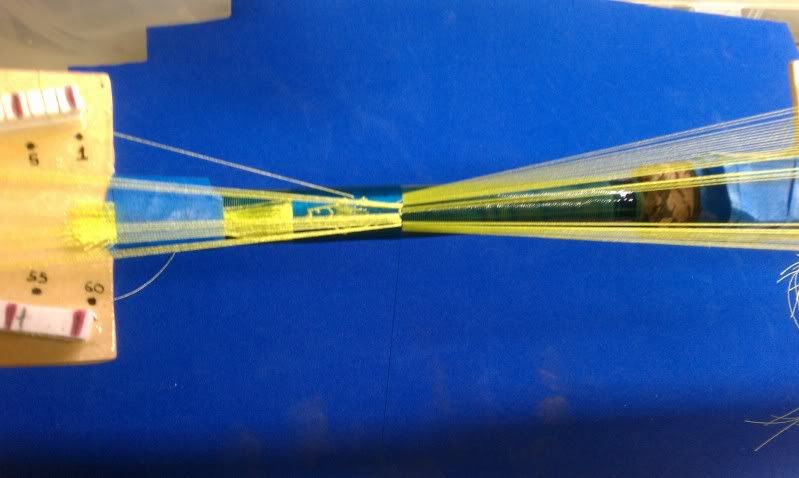
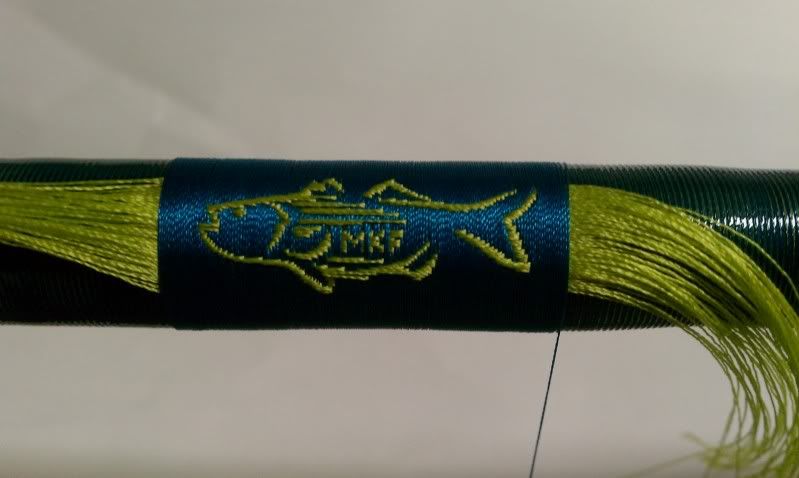
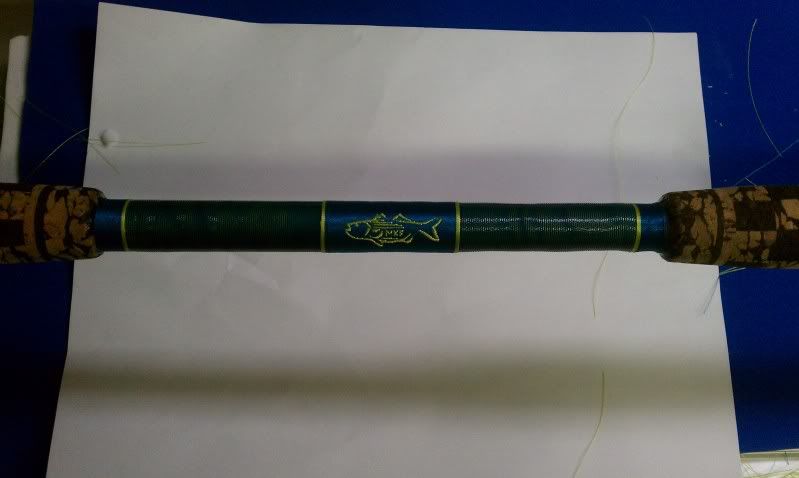
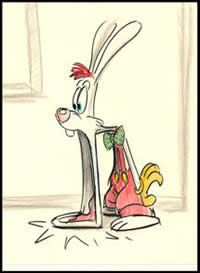


 understandable. If you ever change your mind put me down for one. Thanks for posting your instructables on here. I always enjoy reading them and seeing your work.
understandable. If you ever change your mind put me down for one. Thanks for posting your instructables on here. I always enjoy reading them and seeing your work.
Comment